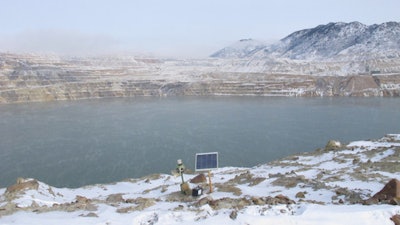
HELENA, Mont. (AP) — After thousands of snow geese died in the toxic water of a former open-pit mine in Montana last fall, the companies responsible for the pit are bringing out the big guns. Literally.
Montana Resources and BP-owned Atlantic Richfield Co. are proposing to use four propane cannons on tripods that would be triggered by long-range motion sensors as one additional measure to scare birds away from the Berkeley Pit during the spring migration.
Also in the plan are radars, air and water drones and strategically positioned lasers that would create a "net" across the pit and deter the birds from landing in the metal-laden water.
The companies want to test those and other technologies during the spring migration period that began Wednesday to prevent another mass bird death like the one that happened in November. Then, 3,000 to 4,000 snow geese died after a snowstorm drove them to seek refuge in the metal-laden water, and the deterrent technology already in place wasn't enough to keep them away.
"It gives us much greater capabilities than we previously had to affect the outcome if another unprecedented event such as this occurs in the future," said Mark Thompson, Montana Resources' environmental affairs manager, of the proposed technology.
The plan is outlined in a memo submitted last month to federal environmental and wildlife officials, which must approve it. If the measures are successful, the companies plan to incorporate some or all of the new technology into their permanent program to keep the birds out of the Berkeley Pit.
The open-pit copper mine stopped operating in the 1980s and is now filled with 50 billion gallons of toxic water drained from the thousands of miles of underground tunnels that lie beneath Butte, once a world leader in copper mining. The Berkeley Pit is now part of the nation's largest Superfund site.
Montana Resources, which operates an adjacent open-pit copper mine, began a waterfowl deterrent program for the Berkeley Pit back in 1995, when 342 snow geese died after landing on the water. The measures included speakers that emit different sounds at random times to scare birds away.
Montana Resources also was fined $30,000 for the 1995 deaths. An investigation is still underway into last fall's deaths, and it has not been determined whether the company will face penalties, U.S. Fish and Wildlife spokesman Ryan Moehring said.
Moehring did not have an immediate comment on whether the new plan would be approved or when.
Some of the proposed technology may not be used even if approval is granted. For example, use of the laser net across the pit and other lasers to shine at approaching birds would require a permit or a waiver by the Federal Aviation Administration, Thompson said.
"The power of the lasers we need right now is something beyond what anybody can buy," he said. "They're highly sensitive to green laser beams."
It's also unclear whether a radar system would work to protect a pit that is 200 feet below where the radar would be set up, Thompson added.
Montana Resources previously tried using a remote-controlled boat to scare birds that land on the water, but its battery died in frigid temperatures and the boat is still floating powerless in the pit. Likewise, a battery controlled air drone used to count the number of dead birds had limitations because the battery kept dying, Moehring said.
The new air and water drones would be gas powered, eliminating the battery problem and adding more noise to frighten the birds, Thompson said.
The cost of the new technology has not been determined, since several items, such as the radar system, will be used at the pit as demonstrations by vendors that the companies will only buy if they are effective, he said.






















